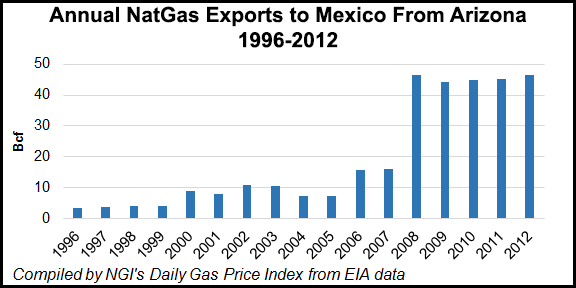Infrastructure | NGI All News Access
Enviros Push Back on Arizona Pipe Lateral to Mexico
Environmental groups in desert lands between Tucson, AZ, and Mexico have asked FERC to reject the current draft environmental impact statement (DEIS) and force Kinder Morgan to look at alternative routes for its proposed Sierrita Pipeline Project, which is slated to connect with a new pipeline in Northern Mexico at the U.S. border.

Comments on the draft DEIS were due last Monday, and 113 filings were submitted, a staff member at the Federal Energy Regulatory Commission told NGI on Wednesday. The comments came from various environmental organizations, local and state elected officials, government agencies and individual citizens.
Reactions were filed in response to the October release of a favorable DEIS (see Daily GPI, Oct. 25), which concluded that “construction and operation of the project would result in limited adverse environmental impacts.”
The Sierrita Pipeline project, a proposed 59-mile, 36-inch diameter pipeline, bids to deliver natural gas to southwestern markets in the United States and high-growth power generation markets in northern Mexico.
The DEIS was based on a review of the information provided by Kinder Morgan’s Sierrita unit and further developed from data requests, FERC staff said in the DEIS [CP13-73, 13-74]. The staff acknowledged that approval of the project would have “some adverse environmental impacts” but said the impacts would be reduced to “less-than-significant levels.”
Nevertheless, going back to late last year when the project was then called the “Sasabe Lateral Pipeline Project” concerns were being raised by local parties. A collaborative conservation group of ranchers and agricultural interests, the Altar Valley Conservation Alliance, urged that an alternative route and entry point into Mexico be found.
“Alliance members and other members of the public have identified alternative entry points that would facilitate the transmission of gas to Mexico while avoiding the numerous, serious adverse impacts that would occur if the pipeline is constructed and operated in the Altar Valley,” Alliance President Patricia King told FERC in a December 2012 filing.
“Until such time as the permitting/FERC certificate process concludes for proposed pipeline projects, route alternatives are always under review by applicants and the commission,” a Houston-based Kinder Morgan spokesperson told NGI on Wednesday. “However, a requirement of this project for our customers is that Sasabe, AZ, is the terminus of the Sierrita Lateral in order for it to connect with a pipeline being built in Mexico [by a unit of San Diego-based Sempra Energy].”
In a filing submitted last Monday, the 41-member Coalition for Sonoran Desert Protection urged FERC not to approve the DEIS and instead declare a “no action alternative” on the environmental review or at minimum require a supplemental DEIS from the proponents. The Sonoran coalition disagrees with the stated purpose of the project, providing “reliable gas transportation” between the United States and Mexico.
Instead, the coalition told FERC the project is “clearly focused on providing benefits to the project proponent and the Mexican public, while leaving the American public with extensive, significant and enduring negative environmental impacts.”
Similarly, the Hopi Native American Tribe’s cultural preservation office supports a call by FERC for a no action alternative, noting that reviews under the Historic Preservation Act have not been completed. “We reiterate our request for continued consultation on this proposal,” said the director of the Hopi Cultural Preservation Office.
Among the varied comments are many from state elected officials, including Andy Biggs, president of the Arizona Senate, supporting the pipeline project’s DEIS.
The U.S. consistently exported between 44-47 Bcf of natural gas to Mexico from Arizona between 2008-2012.
© 2024 Natural Gas Intelligence. All rights reserved.
ISSN © 1532-1231 | ISSN © 2577-9877 |
